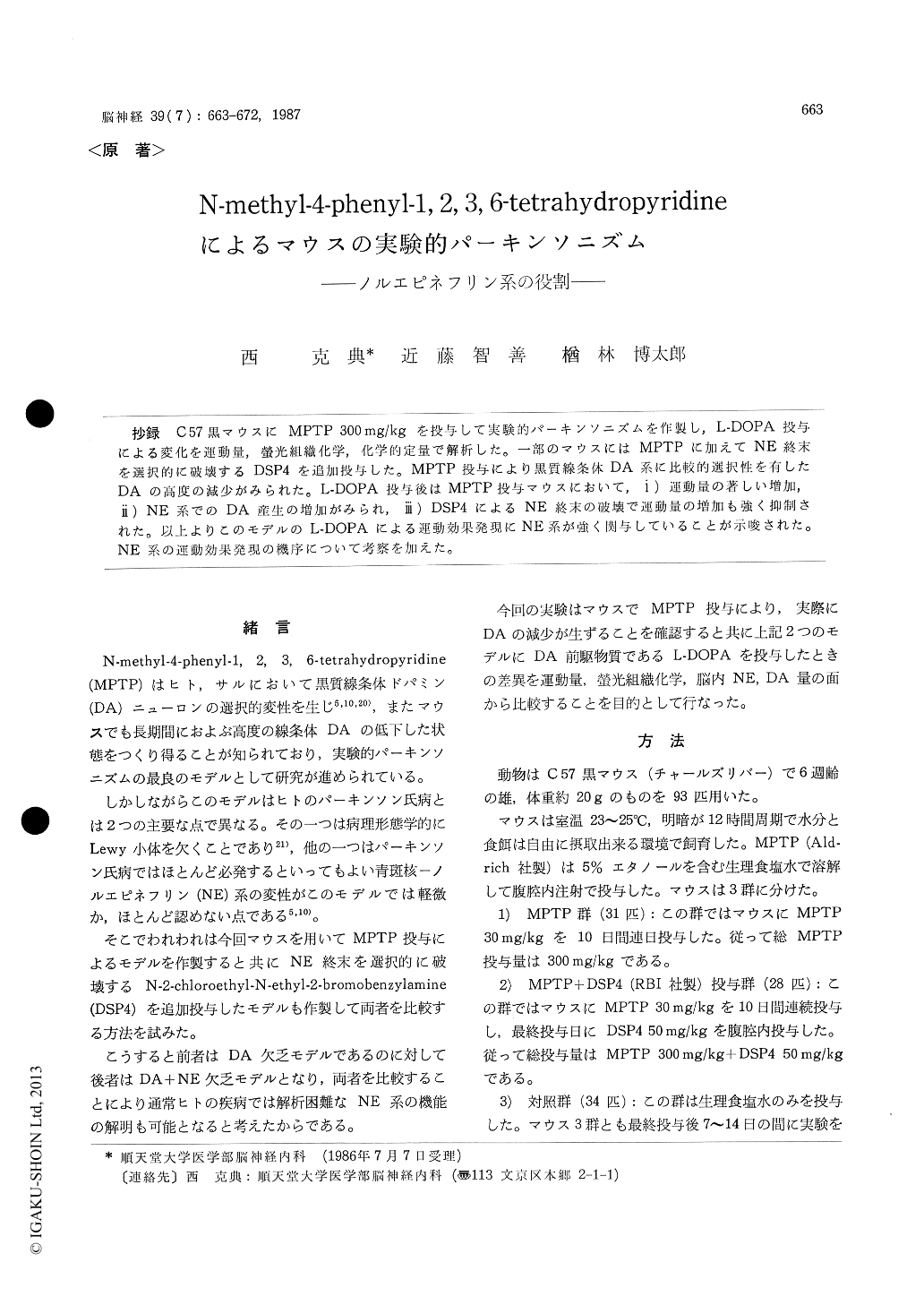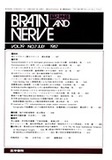Japanese
English
- 有料閲覧
- Abstract 文献概要
- 1ページ目 Look Inside
抄録 C57黒マウスにMPTP 300 mg/kgを投与して実験的パーキンソニズムを作製し,L-DOPA投与による変化を運動量,螢光組織化学,化学的定量で解析した。一部のマウスにはMPTPに加えてNE終末を選択的に破壊するDSP4を追加投与した。MPTP投与により黒質線条体DA系に比較的選択性を有したDAの高度の減少がみられた。L-DOPA投与後はMPTP投与マウスにおいて,i)運動量の著しい増加,ii) NE系でのDA産生の増加がみられ,iii) DSP4によるNE終末の破壊で運動量の増加も強く抑制された。以上よりこのモデルのL-DOPAによる運動効果発現にNE系が強く関与していることが示唆された。NE系の運動効果発現の機序について考察を加えた。
Abstract N-methl-4-phenyl-1, 2, 3, 6-tetrahydropyridine (MPTP) has been reported to cause chronic Par-kinsonism in humans, primates, and long lasting striatal dopamine depletion in mice. Acute animal models thus produced closely resemble Parkinson's disease. There are, however, two major differences. The one is a lack of Lewy bodies and the other is that norepinephrine system is relatively well preserved in the model. So the acute animal model is better considered a nigrostriatal dopamine deficiency model. We have produced another model by adding N-2-chloroethyl-N-ethyl-2-bromobenzyl-amine (DSP4) to MPTP. This material is known to produce selective destruction of norepinephrine terminal in the central nervous system as well as in the periphery. Both norepinephrine system and dopamine system are severely depressed in this model, and the functional role of norepinephrine system was investigated by comparing two models. 90 male C57 black mice weighing 20-25 grams were used.
MPTP (Aldrich) was dissolved in sterile dis-tilled water with 5% ethanol solution. Experi-mental animals were divided into three groups. i) contorl group ; in this group animals received vehicles alone. ii) MPTP group ; in this group, mice received daily i. p. doses of MPTP 30 mg/kg for consecutive 10 days, thus total doses of MPTP was 300 mg/kg. iii) MPTP & DSP4 group ; in this group animals received daily i. p. doses of MPTP 30 mg/kg for consecutive 10 days and at the last day of MPTP injection they received DSP4 50 mg/kg i. p.. 7 to 14 days after the last injection of MPTP both treated and control mice received an intraperitoneal injection of L-DOPA (200 mg/kg & aromatic L-amino acid decarboxylase mg/kg) and the effect of this drug on three groups were investigated by using behavioral, biochemi-cal and histofluorescence method.
Histofluorescence studies by GA-FAS methodrevealed severe reduction of nigrostriatal dopa-mine in MPTP treated mice. Mesolimbic and mesocortical dopamine systems seemed relatively preserved. There was no apparent changes in locus coeruleus norepinephrine system. In MPTP & DSP4 treated mice marked reduction of nor-epinephrine terminal fluorescence as well as nigro-striatal dopamine system was observed. Chemical analysis of norepinephrine and dopamine by HPLC confirmed histofluorescence studies.
Behavioral studies were analyzed by Automex locomotor activity meter. Marked increase of lo-comotor activity was observed in MPTP treated mice after L-DOPA administration. In MPTP & DSP4 treated mice increase of locomotor activity after L-DOPA treatment was moderately suppres-sed. By chemical analysis, norepinephrine and dopamine levels in cerebral cortex and cerebellum increased more in MPTP treated mice than that of control mice after L-DOPA administration. In MPTP & DSP4 treated mice increase of norepine-phrine and dopamine after L-DOPA administration was suppressed moderately.
These results indicate functional importance of dopamine-norepinephrine co-activation in L-DOPA induced increase of locomotor activity.

Copyright © 1987, Igaku-Shoin Ltd. All rights reserved.


